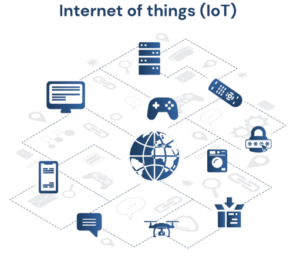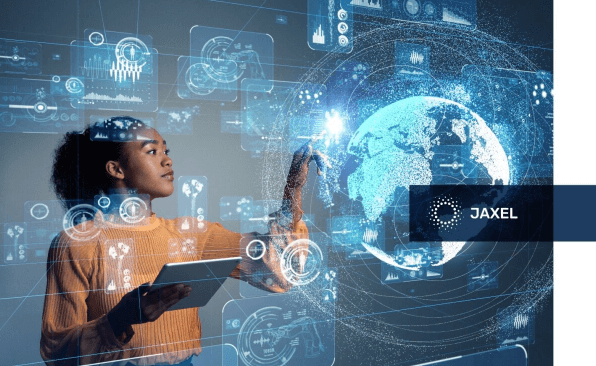What are the Internet of things (IoT) and its scope?
The Internet of Things (IoT) is changing the way we live, work and interact with technology in many different ways. The technology exceeded $100 billion in global sales in 2017; According to predictions, this amount might reach approximately 1.6 trillion by 2023.
As a matter of fact, an IoT network is a collection of internet-enabled devices. Sensors built into these items allow them to gather and share data. The internet of things (IoT) has brought together hardware and software to create a more technologically advanced environment. When it comes to the Internet of Things (IoT), researchers look at how much money is spent in various end-user sectors — such as manufacturing — as well as in health care, electricity, and other types of energy.
Market Overview
Globally, the Internet of Things market is expecting to grow to USD 1,386.06 billion in 2023, from USD 761.4 billion in 2020, a 10.53 percent compound annual growth rate throughout the forecast period (2021-2023). Throughout the Covid-19 epidemic, suppliers are cooperating with a variety of organizations to provide innovative technology-enabled solutions for healthcare institutions to assist them in efficiently overcoming the problem.
- As wireless networking technologies progress, the market is likely to expand at a strong pace in the future years, sophisticated data analytics becomes more prevalent, the cost of smart devices decreases, and cloud platform usage increases.
- The Internet of Things (IoT) is a network of interconnected smart devices that makes it easier to operate and share data amongst them. Sensors, cell phones, and other wearable’s capture data from consumers’ devices, which will use to provide a better experience for those customers. According to a recent report, the Internet of Things industry is growing at a rapid pace throughout this time.
- To put it another way, smart factory automation relies heavily on IoT and Industry 4.0 to design, produce, and manage the whole logistics chain. To keep up with the rapid changes in manufacturing brought on by Industry and the widespread adoption of the Internet of Things, businesses will need to adopt more flexible, intelligent, and creative methods of advancing production with robotics and reducing industrial accidents due to failures.

What are the market trends?
The Retail Sector Is Expected to Grow Significantly
- As a result of the tremendous development of the e-commerce business, the retail industry has grown significantly in the previous two years. Because of this, retailers are turning to the Internet of Things (IoT) technologies to boost both operational efficiency and the consumer experience in order to get an edge over the competition. As a result, the price of IoT sensors and connections is decreasing, consumer demand for a better product is growing, and integrated payment solutions are adopting more widely.
- The Internet of Things (IoT) is having a huge impact on retail operations. Both, in terms of automating processes and increasing operational efficiency. It helps with energy efficiency, security monitoring, inventory management, supply chain management, and human resource management. The Internet of Things (IoT) is also improving its capacity to track temperature-sensitive products such as food and pharmaceuticals.
- Shops and warehouses may be protected by IoT-enabled devices that can survive jamming, thanks to the Internet of Things. RELX, a UK-based company, has opened its first flagship shop in China outfitted with face recognition cameras. These cameras inform workers when a suspicious individual enters the store.
- A better consumer experience may lead to higher profit margins, and IoT is enabling merchants to achieve this goal. Walmart in the US has been testing the Internet-of-things refrigerator door display that uses facial identification technology to offer adverts based on estimated age and gender. Customers in Europe are also using tiny, customizable IoT-connected panels or buttons to collect consumer input and then utilize that information to improve their shopping experiences.

Growth in North America is Expected to Be Significant
- Connected automobiles, smart energy programs, home automation, as well as a renewed emphasis on smart factories in North America. They are likely to fuel the region’s IoT future growth over the next several years. Additional factors that have helped IoT in this area expand include growing digitization across many industries and technical improvements.
- Automated solutions for the home are very popular in the region. Linked cameras (the most popular), video doorbells, attached bulbs, smart locks, and headphone amplifiers are among the most popular new additions to people’s homes. In North American households, the greatest concentration of Internet of Things (IoT) devices is found, as per Stanford University and vast research. Intriguingly, 66% of the region’s households include at least one Internet of Things (IoT) device. In addition, 25% of North American households have more than two gadgets in their homes. According to a study, by 2022, over half of all gadgets and connections will be video-capable in the state’s homes.
What are the strategies of IoT?
There are three strategies for IoT success:
- Quick access to the data may help you save time and money.
- Gain a competitive edge by gaining access to fresh data.
- New processes and business concepts may help you transform your company.
How much is the IoT market worth?
Since the worldwide industry for Internet of Things (IoT) final solutions is expecting to reach 212 billion US dollars by the end of 2019. With projections predicting it would reach $1.6 trillion by 2023. It’s the first time that technology has surpassed $100 billion in market sales.
Developments of IoT in the coming decade
In the future decade, here are six IoT developments that we may expect to observe.
- Security of the Internet of Things (IoT) is becoming a top priority.
- The Importance of “Edge Computing”
- New Methods for Gathering Large Amounts of Data
- Medical Devices Connected to the Web
- Smart Cities
- Internet of Things (IoT) Adoption in the Industrial Sector

Future of the internet of things:
New advancements in the Internet of Things have caught the interest of academics and developers globally. Developers and researchers are working together to advance the Internet of Things and maximize its societal advantages. However, developments are possible only if we consider the many difficulties and shortcomings associated with present technical procedures. In this survey article, we highlighted a variety of problems and roadblocks. IoT developers must consider these problems while creating an upgraded model.
Additionally, the report highlights important IoT application areas, as well as the work of IoT developers and researchers. Consequently, the usefulness of big data analytics is examined, as it has the potential to provide exact findings that may be utilized to improve an IoT system.
See also
https://jaxel.com/3-iot-applications-that-will-save-your-business-money/
https://jaxel.com/9-benefits-of-cloud-computing-everyone-needs-to-know/









